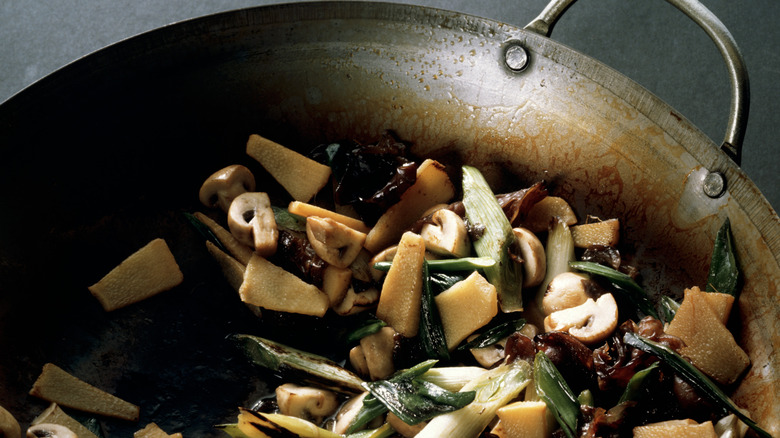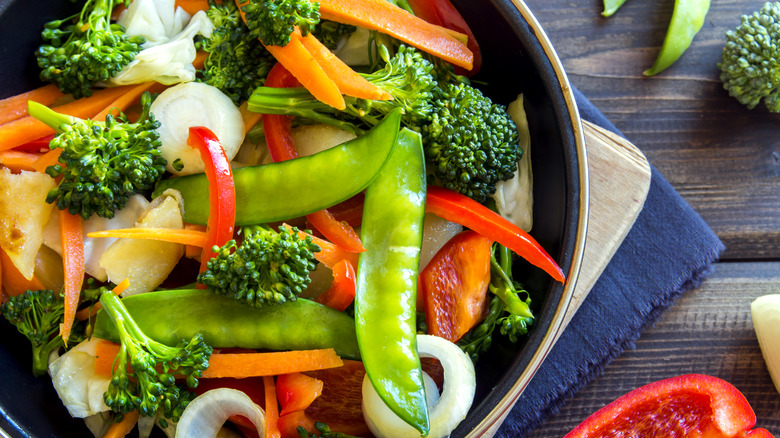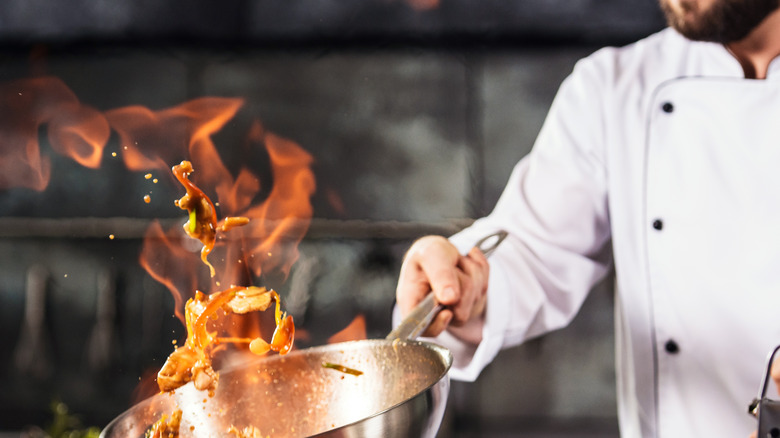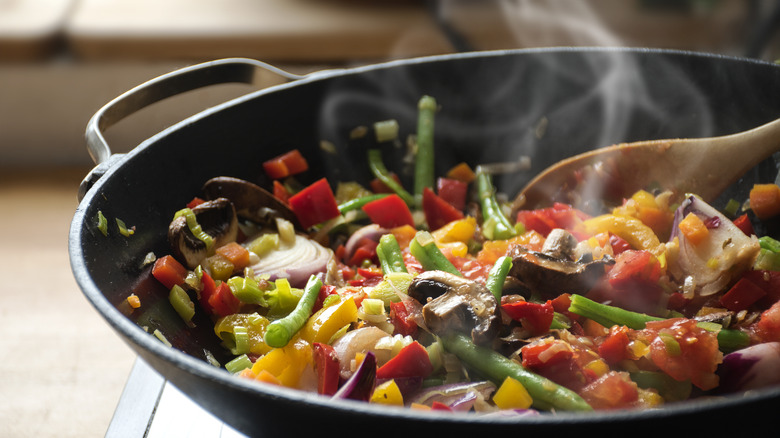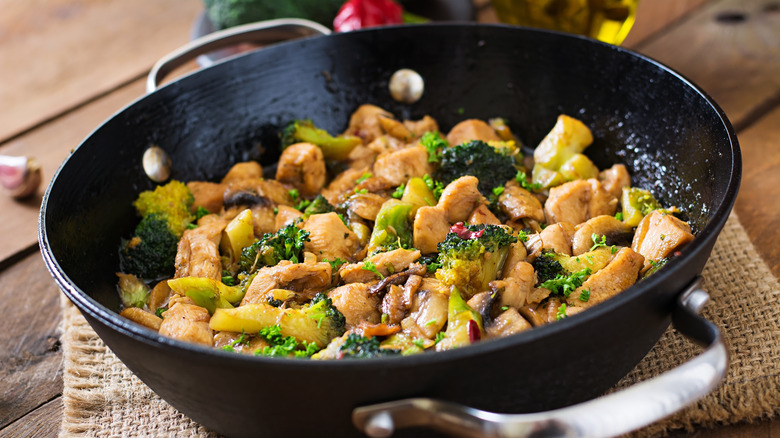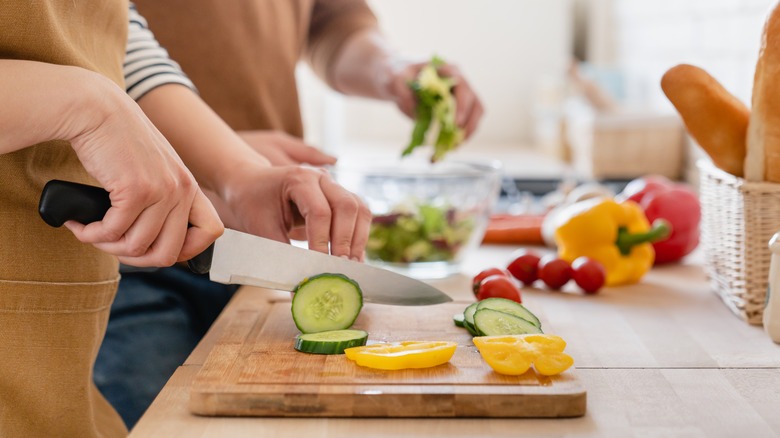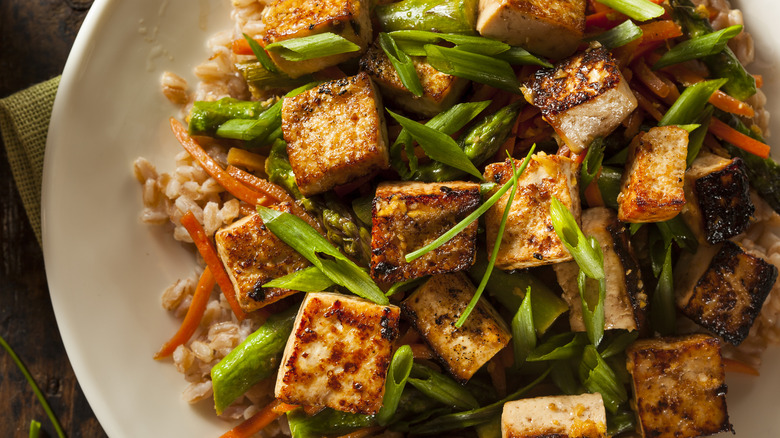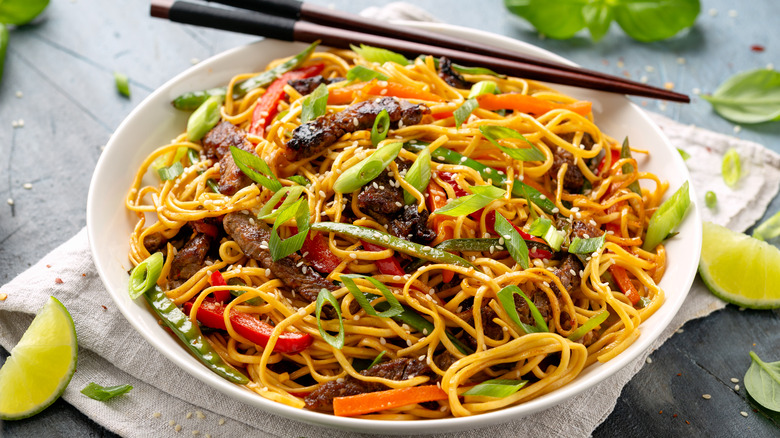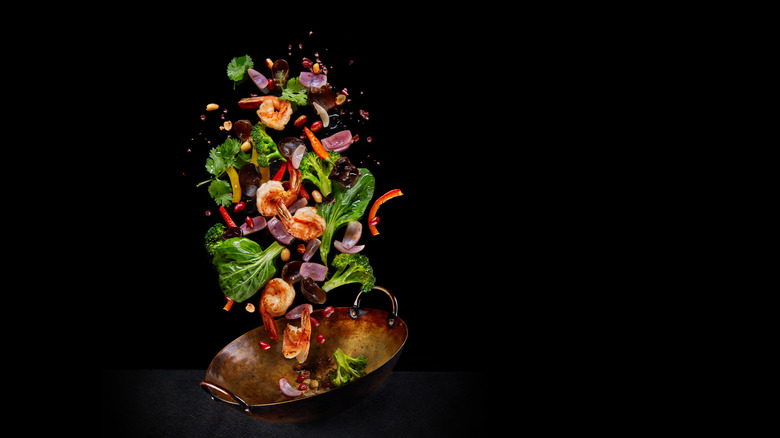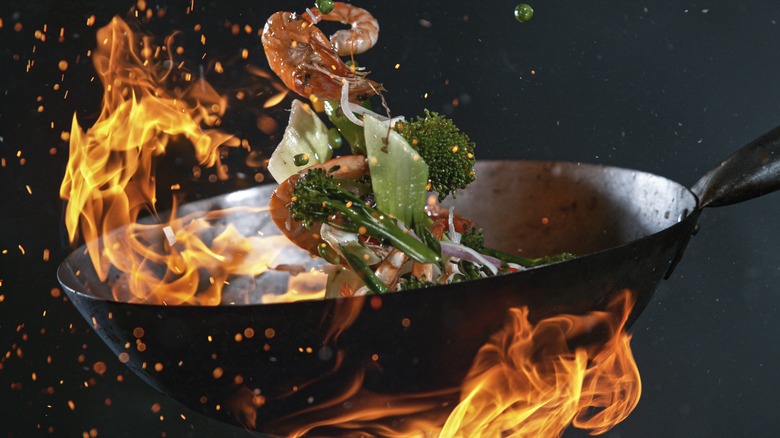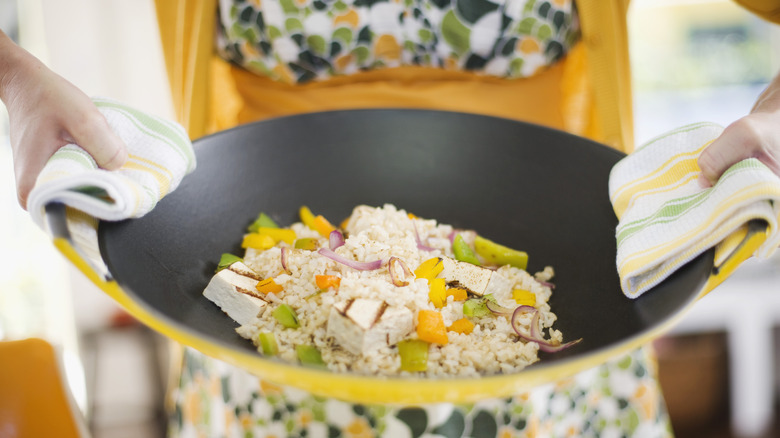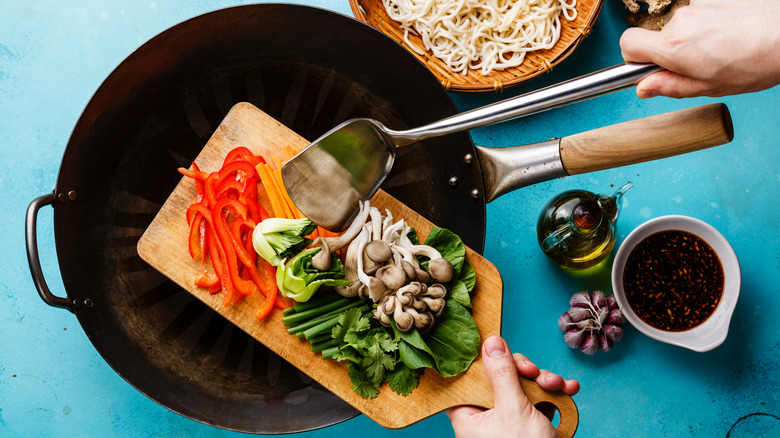Mistakes Everyone Makes When Making Stir-Fry
Cooks in China originally developed stir-frying -– the technique of quickly sautéing small pieces of food over high heat in a wok -– as a way to make the most of scarce fuel, according to Cooking Light. Because stir-frying kept cooking times brief, it was a great way to get a hot meal on the table without burning through one's firewood supply.
While modern cooks rarely worry about running out of cooking fuel, they still appreciate stir-fry meals for their speed, not to mention their flavor, color, and versatility. But all too often, home cooks' visions of Chinatown-level dishes with every ingredient perfectly cooked and seasoned are met with a disappointing reality: a plate of soggy, flavorless stuff that no self-respecting restaurant would admit to making. The reality is that fast cooking doesn't mean easy or mindless cooking. While a stir-fry comes together quickly, making it right requires finesse, planning, and an understanding of a few basic principles — along with awareness of the common mistakes you need to avoid at all costs.
Not having all your ingredients prepared before you start cooking
A fundamental error when making a stir-fry is starting to cook without being fully prepared. As London chef and TV personality Jeremy Pang told MyLondon, preparation is paramount. In short, your stir-fry is a bit like a military battle: The actual action unfolds quickly, but the quality of your planning and preparation beforehand will be a deciding factor in your success. So while the cooking takes just a few minutes, you need to allot time for measuring and preparing your stir-fry ingredients before you even heat your wok.
And it's not enough just to prep your ingredients beforehand -– you need to keep everything organized and easily within reach when you start to stir-fry. (This practice, called mise en place in classical French cuisine, is also considered a best practice in Western cooking.) Once you start cooking, you won't have time to run to the fridge for the veggies you prepped earlier, nor will you have time to keep referring back to your recipe to find out what ingredients need to be added next. Pang recommends an organizational strategy he dubs the "wok clock:" arranging your prepped and measured ingredients on a plate, like numbers on a clock, in the order in which they are to be added. This will not only ensure nothing's missing, but it will also help you visualize the next steps in your recipe as you cook.
Not heating your wok or pan enough
A well-made stir-fry has a special flavor and aroma — a touch of smokiness, similar to the scent of a just-grilled steak. But attaining this distinctive characteristic, known as wok hei (literally, "the breath of the wok" in Cantonese), according to the Michelin Guide) is frustratingly elusive for most home cooks. Even if they think they're doing everything else right — sourcing the proper ingredients, cutting everything into the right shapes, according to the recipe — they inevitably end up with a so-so sauté rather than a restaurant-quality stir-fry.
The reason for this, explains San Francisco chef Kathy Fang, co-owner of Fang Restaurant and star of the upcoming Food Network series "Chef Dynasty: House of Fang," is that classic stir-frying requires seriously high heat. This heat is responsible for the caramelization and smokiness that distinguish a proper stir fry. "A lot of people get impatient, and so they immediately add their ingredients, say the protein, into a pan before it's even hot enough. And if you do that, you ruin your stir-fry from that moment, and you can't fix it," Fang explained to Mashed. "[If] heat is too low, that thing's going to sit on there and start releasing liquid. It has this bad color to it. It's very hard to fix at that point." So the lesson is to take your time to thoroughly preheat your pan or wok — the extra few minutes will be well worth it.
Letting your wok or pan cool down during cooking
Because intense heat is critical for a proper stir-fry, it's not enough just to preheat your wok or pan thoroughly before cooking — you also have to make sure it stays hot throughout the entire cooking process. As London chef Jeremy Pang tells MyLondon, it's easy for home cooks to forget that any number of seemingly harmless actions can cause even a well-heated pan to suddenly cool down, from stirring food around to adding cold food to moving the wok while cooking.
The remedy for this, he explained, is keeping a watchful eye and ear on your wok or pan as you cook. "One of my catchphrases is 'never lose your sizzle,'" he told MyLondon. "If you don't hear something sizzling, especially stir-frying, then you're not stir-frying -– you're stir-boiling." To keep your wok hot as you build your stir-fry, he recommends waiting 30 seconds after the addition of each new ingredient before adding anything else. This wait period, he explains, will give your wok adequate time to regain lost heat. "That 30-second wait makes a massive difference to the finish of the stir-fry," he said.
Burning your aromatics
The flavor backbone of a classic Chinese stir-fry is what San Francisco chef Kathy Fang calls "the holy trinity" of aromatics -– ginger, garlic, and scallions. These appear in most traditional stir-fry recipes, and many of these recipes call for adding these aromatics to the wok before other ingredients to flavor the oil — and thus flavor the whole dish. But as a discussion on eGullet reveals, many home cooks find to their dismay that doing this burns their aromatics. Thus, some argue that aromatics should be added at the end of cooking instead.
But Fang tells Mashed that the proper treatment of aromatics is not an either/or proposition. "It depends on how large your aromatics are cut. So if you're mincing your aromatics, such as ginger and scallions and garlic, then I wouldn't put the garlic in the beginning. You could possibly put the ginger in the beginning, but not the scallions. Those are meant to be finishers," she said. "Then you add the aromatics at the end to bring it together, and that becomes part of the sauce."
She added that aromatics cut into larger pieces, however, can be added to saucier dishes at the beginning of cooking. "And typically in these circumstances, your sauce is a little heavier and thicker. So those ingredients start to kind of almost simmer in that sauce a little bit," she said. "So it depends on how you're treating the aromatics — that determines when you actually add it in."
Cutting your ingredients into uneven sizes
When it comes to stir-frying, size matters: How large or small you cut your ingredients will not only determine the final look of your dish, but also how quickly your ingredients will cook. So another no-no when stir-frying is thinking any randomly cut ingredients will work. As Michelle Sam at Sammy Wong's Kitchen reminds us, stir-frying was invented by cooks and diners who ate with chopsticks, so whatever ingredients you include should be cut into sizes that a diner can easily manage with chopsticks -– ideally, bite-sized or smaller. In addition, all ingredients in a dish should be cut into similar sizes, to ensure both consistent cooking and a harmonious-looking finished dish.
In addition, restaurateur and chef Kathy Fang explained to Mashed that manipulating the size of your cuts — especially with meat — can help home cooks compensate for the absence of a real wok or high-powered professional stove. "With a non-sick pan and electrical stove, all you need is, No. 1, to manipulate the protein. What we look for is very, very tender protein in a stir-fry," she said. "And to accomplish that with low heat or minimal heat, you have to cut the protein very, very small. So either slice it very thin or dice it into very little cubes that are like half inch cubes or less." This strategy helps home cooks get the most from their limited heat sources by maximizing surface area and promoting caramelization and the development of flavor.
Cutting your ingredients into the wrong shapes
Another common mistake is cutting your stir-fry ingredients into random shapes. The shape of your ingredients really does matter, both for the appearance of the final dish and its mouthfeel and taste. You've probably noticed that in your favorite restaurant stir-fries, most of the ingredients are cut into similar shapes –- if the meat is in cubes, most of the vegetables will be cut into chunks or cubes as well. And if the meat is julienned, chances are, the vegetables in the dish will be, too.
This is by tradition and by intention, according to The Woks of Life. In general, the desired shape of your protein or other main ingredient should determine the shape of your supporting ingredients. If you want your finished dish to showcase thicker slices of meat, for example, the vegetables should also be in thick slices. But if you want finely sliced or julienned meat (as in moo shu pork, for example), the other ingredients should be cut similarly. This will ensure that your dish not only looks harmonious, but that all ingredients cook at roughly the same rate. And pay attention to the grain of your meat when cutting it — to ensure tenderness, cookbook author Grace Young advised The Oregonian, meat for stir-fries should always be cut against the grain.
Cooking all your ingredients at the same time
A common misconception about stir-frying is that everything gets cooked together at the same time. But according to restaurateur and chef Kathy Fang, nothing can be further from the truth. "The other big no-no is people think that you're supposed to add the vegetables into the pan with the meat and cook everything until it's done," she told Mashed. But doing this, however, will give you an unevenly cooked, soggy mess. Instead, you have to understand the ingredients you're working with and cook them in stages. For instance, proteins are typically cooked first, then set aside and returned to the wok later, and vegetables that take longer to cook, such as carrots and broccoli, are blanched before being added to the wok.
"Stir-fry is all about timing," Fang explained. "You have to time. So in Chinese cooking, actually, sometimes you time the different vegetables. So you don't even cook all the vegetables at the same time, even if you blanch [them]. We blanch the broccoli first, and then we do the snap peas right after. And then the zucchini. Everything's about timing, so everything's cooked perfectly."
Overcrowding your wok or pan
To get the characteristic toasty, smoky flavor of a classic stir-fry, it's essential that your wok or pan stay hot so every ingredient gets the full impact of the wok's heat. And to ensure every ingredient gets good heat exposure, it's critical to maximize each ingredient's contact with the wok's hot surface. Thus, as chef Andrew Zimmern explains, you need to avoid the temptation to overfill your wok, even if you're cooking for a crowd.
As cookbook author Grace Young explained to The Oregonian, overfilling your wok will cause the wok's temperature to plummet, resulting in your ingredients simmering, rather than stir-frying. Crowding your wok with meat, for instance, will cause it to release liquid and foam, rather than sear — not a good look. To further ensure the proper sear of ingredients and avoid inadvertently steaming them while stir-frying, Young recommends ensuring all ingredients are as dry as possible when added to your stir-fry — for instance, ginger and garlic should be minced rather than grated to keep them from releasing juice, and vegetables should be patted dry with paper towels before cooking.
Using the wrong pan
There's a reason woks and stir-frying are indelibly linked -– the technique of stir-frying was developed specifically to leverage the expansive surface area and heating capabilities offered by a wok (per Cooking Light), and some experts insist that the only way to ensure your stir-fries have the proper flavor is to use a classic Chinese wok. Cookbook author Grace Young, for example, even brings her own well-seasoned carbon steel wok with her when she travels for cooking demonstrations (per The Oregonian). "A carbon-steel wok is always better than a skillet," Young told The New York Times.
Young warns specifically against using nonstick skillets and woks, which she says not only don't allow the characteristic sear offered by a wok, but also can't be safely heated to a sufficiently high temperature. However, restaurateur and chef Kathy Fang says that for home cooks not ready to commit to seasoning and maintaining a carbon steel wok, a Calphalon wok will work fine. "If you actually get a real serious wok, then you got to really take care of it. You've got to season the wok well, the way that you clean it, everything. The way that you handle the wok will matter a lot," she told Mashed. "So I would start with the Calphalon wok. And then if you're like, 'Oh, I mastered that,' then move on to the serious Chinese woks."
Using the wrong oil
Your choice of oil matters when stir-frying -– and the right oils might not be what you think. "[The] No. 1 no-no is the oil," restaurateur and chef Kathy Fang explained to Mashed. "A lot of people think, 'Oh, I can actually stir-fry with olive oil or just whatever oil that I have at home.' Or people use sesame oil because they think, well, that's an Asian-centric oil. Then I can stir-fry. Sesame oil actually does not work well in stir-fry. It works great in marinades and as a finishing oil, but when you cook it in high heat, it actually changes the flavor of the oil. So no olive oil, no sesame oil."
Instead, Fang recommends using neutrally flavored oils with a high smoking point, such as canola oil, grapeseed oil, or avocado oil, which can tolerate high heat without tasting burnt or contributing any off flavors — this will help sear your ingredients and showcase their flavors.
Under-seasoning your stir-fry
While not all stir-fries need a lot of sauce — or any, for that matter — they do need good, punchy flavoring. While it's laudable to want to put the flavors of your main ingredients front and center, without giving them a little help, you're likely to end up with a bland, boring stir-fry. As noted by The Woks of Life, even a simple, mildly flavored dish such as chicken and snow peas contains ample seasoning — chicken stock, white pepper, sesame oil, and oyster sauce — which highlight the main ingredients without overwhelming them.
And when it comes to seasoning your stir-fry, details matter. Chef and restaurateur Kathy Fang, for instance, always marinates the meat for her stir-fries before cooking. "All proteins should be marinated for about 10 minutes. And that 10-minute marinade includes corn starch, which actually helps seal the protein with the seasoning," she explained to Mashed. A typical marinade, she added, includes soy sauce, white pepper, garlic, or other seasonings, depending on the dish, and the cornstarch, which also seals in the meat's juices and promotes searing.
